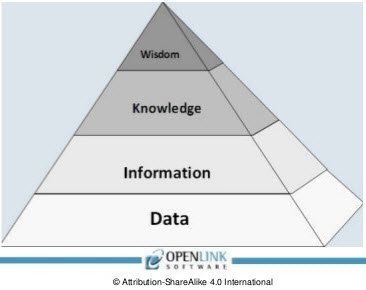Kingsey Idehen's presentation Understanding Data is worth watching if you are trying to work with XBRL. Why do you care about data? Do you care about wisdom? Data is the foundation of all wisdom:
The presentation points out two common models for representing information.
One common representation model is the Entity Attribute Value (EAV) model:
- Entity
- Attribute
- Value
Another common representation model is the Resource Description Framework (RDF):
- Subject
- Predicate
- Object
There are other representation models.
XBRL is also a representation model. XBRL uses the XLink syntax to express some relations. Many people understand the presentation and calculations relations of XBRL. Fewer understand XBRL definition relations. The XBRL Definition Linkbase is a general way of expressing relations. You can create relations between any Table (hypercube), Axis (dimension), Member, LineItems (primary items), Concept or Abstract that you want. An arcrole describes the relation, it is the "predicate". So, in XBRL the model is something like this:
- From some report element (Table, Axis, Member, LineItems, Concept, Abstract)
- Some arcrole
- To some report element (Table, Axis, Member, LineItems, Concept, Abstract)
There are other ways to represent things and relations between things in XBRL. XBRL Formula is one.
While some aspects of reality are disputable, other aspects of reality are agreed upon. Knowledge is justified true belief. If you can justify something, then it can be believed to be true. XBRL Definition Relations and other models can be used to express your reality. Part of my reality is that "Assets = Liabilities and Equity". How do I know that to be true? Well, I learned that in accounting school, it is the accounting equation.
The vast majority of SEC XBRL financial filings have assets which equal liabilities and equity. It is certainly not false. For those SEC XBRL financial filings where assets does not equal liabilities and equity; are they wrong? That is easy to determine. Look at each one and determine for yourself whether their assets should equal liabilities and equity or not.
The model approach or syntax of the model matters less. Using either approach or whatever syntax, each representation will reconcile to each other. And each model/syntax should also reconcile to reality as the user of the model sees it.
